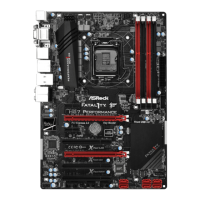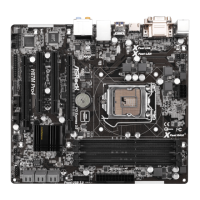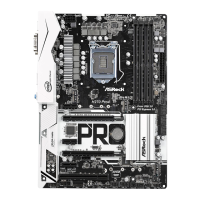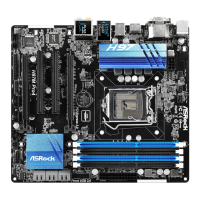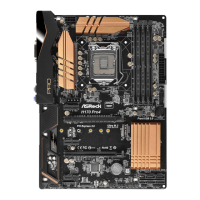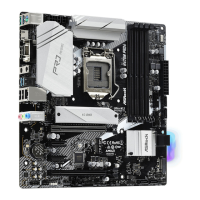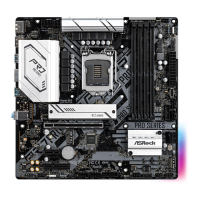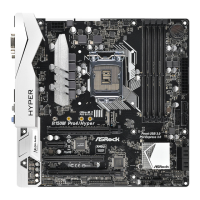
Do you have a question about the ASROCK H87 Pro4 and is the answer not in the manual?
| Non-ECC | Yes |
|---|---|
| Memory channels | Dual-channel |
| Memory slots type | DIMM |
| Number of memory slots | 4 |
| Supported memory types | DDR3-SDRAM |
| Maximum internal memory | 32 GB |
| Supported memory clock speeds | 1066, 1333, 1600 MHz |
| Supported memory module capacities | 2GB, 4GB, 8GB |
| Processor socket | LGA 1150 (Socket H3) |
| Processor manufacturer | Intel |
| Compatible processor series | Intel Celeron, Intel Pentium |
| Maximum number of SMP processors | 1 |
| USB 2.0 connectors | 2 |
| Number of SATA III connectors | 6 |
| USB 3.2 Gen 1 (3.1 Gen 1) connectors | 0 |
| USB 2.0 ports quantity | USB 2.0 ports have a data transmission speed of 480 Mbps, and are backwards compatible with USB 1.1 ports. You can connect all kinds of peripheral devices to them. |
| Certification | FCC, CE, WHQL |
| Component for | PC |
| Motherboard chipset | Intel® H87 |
| Audio output channels | 7.1 channels |
| Motherboard form factor | ATX |
| Windows operating systems supported | Windows 7 Home Basic, Windows 7 Home Basic x64, Windows 7 Home Premium, Windows 7 Home Premium x64, Windows 7 Professional, Windows 7 Professional x64, Windows 7 Starter, Windows 7 Starter x64, Windows 7 Ultimate, Windows 7 Ultimate x64, Windows 8, Windows 8 Enterprise, Windows 8 Enterprise x64, Windows 8 Pro, Windows 8 Pro x64, Windows 8 x64 |
| RAID levels | 0, 1, 5, 10 |
| Supported storage drive interfaces | SATA III |
| Maximum resolution | 1920 x 1200 pixels |
| Parallel processing technology support | - |
| PCI Express x1 slots | 3 |
| PCI Express slots version | 2.0, 3.0 |
| Cables included | SATA |
| LAN controller | Intel® I217-V |
| Ethernet interface type | Fast Ethernet, Gigabit Ethernet |
| BIOS type | UEFI AMI |
| ACPI version | 1.1 |
| BIOS memory size | 64 Mbit |
| Width | - mm |
|---|
Lists all components included in the motherboard package, such as the motherboard itself, cables, and manuals.
Provides comprehensive technical details on the platform, CPU, chipset, memory, expansion slots, graphics, audio, LAN, and rear panel I/O.
Details ASRock's proprietary technologies and software utilities, including A-Tuning, Instant Flash, APP Charger, and XFast USB/LAN.
Illustrates the physical layout of the motherboard, identifying key components, connectors, and slots with corresponding numbers.
Details the rear panel connectors, including USB, audio, video outputs, LAN, and PS/2 ports, with their respective functions.
Provides a detailed, step-by-step visual guide on how to correctly and safely install the CPU into the motherboard socket.
Guides users through the process of installing the CPU fan and heatsink assembly onto the motherboard for proper cooling.
Explains how to properly install DDR3 DIMM modules into the motherboard slots, emphasizing dual-channel configuration.
Describes the types and uses of PCI and PCI Express slots available on the motherboard for adding expansion cards.
Details the setup and function of motherboard jumpers, specifically the Clear CMOS jumper for resetting BIOS settings.
Explains the purpose and connection of various onboard headers for system panel functions, power LEDs, and front panel connectors.
Provides instructions for installing necessary drivers and utilities from the included support CD for optimal system performance.
Details the ASRock A-Tuning utility, covering its operation modes, tools, and system information features for performance tuning.
Explains how to set up Intel® Rapid Start Technology to enable faster system wake-up from deep sleep states.
Details the setup and usage of Intel® Smart Connect Technology for automatic content updates while the PC is in sleep mode.
Explains how to configure Intel® Remote Wake Technology using MeshCentral for remote PC wake-up and control.
Introduces Intel® Extreme Tuning Utility (IXTU) for system performance optimization, detailing its UI overview and tuning capabilities.
Provides an introduction to the ASRock Interactive UEFI setup utility, explaining its interface and navigation.
Describes the main screen of the UEFI Setup Utility, which displays a system overview including BIOS version and memory status.
Details the OC Tweaker screen in UEFI, focusing on CPU Ratio, Intel SpeedStep, and Turbo Boost Technology for overclocking.
Covers CPU-specific settings within the UEFI, including Hyper Threading, processor cores, and power state configurations.
Explains chipset configuration settings, such as primary graphics adapter, PCIe link speed, and onboard device enablement.
Details storage configuration options, including SATA controller enablement, mode selection (IDE/AHCI/RAID), and SMART settings.
Explains how to enable Intel® Rapid Start Technology within the UEFI for faster system resume.
Details how to enable Intel® Smart Connect Technology in UEFI for automatic content updates during sleep.
Covers ACPI settings in UEFI, including suspend states, wake-up events, and power management features.
Explains UEFI settings for USB controllers, including legacy support and USB 3.0 enablement.
Details the various tools available in the UEFI, such as OMG, Tech Service, and RAID/Driver Installers.
Describes the H/W Monitor screen for checking system hardware status, including CPU temperature, fan speeds, and voltages.
Covers boot settings in UEFI, such as boot option priorities, Fast Boot options, and CSM compatibility support.
Explains security settings in UEFI, including supervisor and user passwords, and enabling Secure Boot for enhanced system protection.
Details options for saving changes, discarding changes, and loading default settings before exiting the UEFI utility.

